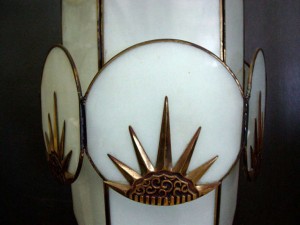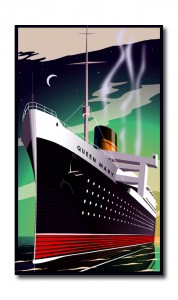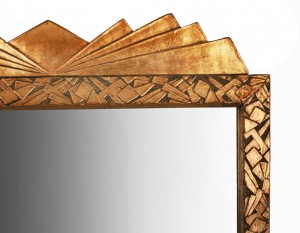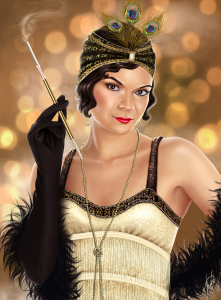By Michael Pacitti
Period design is a fascinating field of study, and one that can help you do better business. Behind each frame lies a story that’s well worth knowing—and sharing. Did you know that most frames fall into one of thirteen periods of design? Knowing and understanding all the influences behind a frame can really help to hone your skills as a custom framing designer. And this, in turn, will bring you more satisfied customers.
So without further adieu, let’s dive into this issue’s featured period of design!
Art Deco: 1925 – 1937
No doubt you’re aware that Art Deco is hot right now! Part of the reason was last year’s movie remake of F. Scott Fitzgerald’s “The Great Gatsby,” with a star-studded cast including Leonardo DiCaprio, Tobey McGuire and Carey Mulligan.
If you saw the film, you’ll recall the rich, opulent ‘20s glamour of the costumes and set. This was a sparkling, smoke-swirled era with glittering sequins, lavish beading, polished hardwoods and elaborate, over-the-top splendor. Box office reviews for the movie may have been mixed, but the fashion trends had already caught on.
Pantone announced an Art Deco emerald green for the color of 2013. Hipsters across the country started sporting suspenders and bowties. Rolls Royce announced a new, Art Deco-styled vehicle. Kitchen fixtures began cropping up in shiny, nickel-plated styles. And of course, Art Deco frames grew in popularity.
Hallmarks of Art Deco
Let’s review the classic hallmarks of Art Deco. Clean lines, geometric shapes and grayed colors are a good place to start. We’re talking dove gray, flat silver, brilliant red, soft lilac and emerald green—this is the basic palette— set against exotic woods such as Makassar ebony, zebrawood, and the refined metals of bronze, brushed steel and nickel.
Art Deco’s visual motifs include geometric shapes, curves, Egyptian zigzags, sunburst,
lightning bolts, airbrushed screened ray bands, motion light, aerodynamic and streamlined forms. Glamorous ornamentation is another hallmarks of the Art Deco period. The more lavish, the better.
Influences and Background
There’s a lot of interesting history behind the Art Deco movement, and it’s well worth knowing. Let’s dive into it.
Art Deco holds some wonderful paradoxes. On the one hand, it is considered a supremely theatrical, ornate style; yet it is also classical and symmetrical. The movement drew its inspiration from art genres including Cubism, Futurism, Neoclassicism, Modernism, Futurism and the Bauhaus era. Art Deco’s true heyday was from 1925 to 1937, though things started up as early as 1920.
Think of the Roaring Twenties—the Jazz Age, with flappers kicking their sequined heels up at raucous, lavish parties. It was a glamorous time, but it was also an era that embraced technology. This is a key distinguishing factor between Art Deco and the Art Nouveau period, with its organic motifs.

Ancient Egyptian influences: the classic sunburst pattern, shown here in white and gold stained glass.
Although many other design movements have political or philosophical roots or intentions such as Art Nouveau, Art Deco was purely decorative. It was bold and brassy and powerful. It took buildings and designed them to look like cruise ships!
Discoveries, Motifs and Ornamentation
In 1922, archaeologist Howard Carter and his sponsor, Lord Carnarvon, thrilled the
world with their discovery of the tomb of King Tutankhamen. Reporters and tourists
thronged at the site for a glimpse at treasures which had lain nearly undisturbed for over 3,000 years. Soon, a fascination for ancient Egypt found expression in clothing, jewelry,
furniture, graphic design and, of course, architecture. In fact, one of the most popular Art Deco motifs is that of the sunburst pattern, taken from Egyptian hieroglyphs and symbols.
Art and Posters
Although the term “Art Deco” is rarely applied to painting or sculpture, the style is visible in the streamlined forms of certain 20th century painters from the inter-war period. One of the most famous artists who employed Art Deco themes was painter Tamara de Lempicka (1898-1980). A bold, fiercely independent woman (with a fascinating life story), Lempicka revolutionized the world of female portraits. She embraced the “synthetic cubist” method of painting, using small, geometric planes of strong color to create stunning, empowering portraits of women.

The Queen Mary Poster, by Rudy Gardea. On August 30, 1939, the Queen Mary departed on her last peacetime voyage.
Along with the technological advances of the era, the art world saw dramatic evolution in the world of printmaking and lithography. As a result, Art Deco posters became available to many who might not otherwise be able to afford the original artwork. These images endure today.
Lempicka’s prints were (and are) popular, as were images in the “Cassandre Style,” so named after the pseudonym of the famous artist Adolphe Jean-Marie Mouron, who held a one-man show at the Museum of Modern Art in 1936. No doubt you are familiar with Cassandre’s sleek designs of towering ships and speeding trains—the pinnacle of Art Deco graphic design. Pinup posters and advertisements were popular as well.
Fashion
The fashion-forward clan knew exactly what they wanted after the end of World War I, when technological advances kicked into high gear. It was time to move beyond the hardship and into an era of empowerment for women. Flapper fashion was born. Long-waisted dresses, V-necklines and ostrich feathers celebrated women’s femininity, while bobbed haircuts brought a dash of erotic androgyny into the mix.

Picture Frames, Photo Frames & Mouldings
Now that we’ve explored the history and hallmarks of the Art Deco period, let’s bring the discussion back to framing. Here’s where we start to put it all together in terms of your business and clients.
Art Deco mouldings and frames tend to have clean, smooth finishes. They hold a characteristic of not only symmetry, but also a consistency in finish and color. Whether you’re talking about a painted green frame or one made of highly polished metal, it will have clean-cut lines that will beautifully compliment any art deco art image or photograph. Aluminum, stainless steel, plastics, lacquer and inlaid wood are excellent choices.
Have a client who wants to frame a poster of the Chrysler Building or a classic Tamara de Lempicka print? Get a slick, polished frame and set it off beautifully. Loft owners and condo dwellers—especially those with high ceilings—are looking for Art Deco stylings whether they know it or not!
Framing Art Deco posters requires a moulding that is clean, flat and symmetrical in pattern and ornament. Try pairing the image or subject matter that you are designing with frames that have geometric or stylized patterns from representational forms (remember the Egyptian sun we discussed above?). Bear in mind: Art Deco often incorporates a repetitive pattern throughout the image. Choose mouldings that are cool, elegant and sophisticated. You are looking for symmetry, clean lines and geometric patterns.
Furniture and Decor
In the wake of the Gatsby style resurgence we’re seeing, interior decorators and designers are incorporating Art Deco themes into their decor these days as well. The original Art Deco furniture was an amalgam of many different styles and movements of the early 20th century—including Neoclassical, Constructivism, Cubism, Modernism, Art Nouveau, and Futurism—and that’s what we’re seeing again today.
Art Deco decor is characterized by the use of materials such as aluminum, stainless steel, leather, lacquer, inlaid wood and exotic materials such as ivory, shark skin and zebra skin. Functional elegance is the key. Other elements include: high-gloss finishes, glass
and metal combinations, geometric shapes and bold patterns (think animal prints). Keep these in mind when working with an Art Deco artwork and/or frame.
Inspiration and Resources
If you want help your clients to create a space in which their apartment, home or loft looks and feels as though they have a roommate named Gatsby, the following websites
are good places to start.
Houzz.com
Houzz.com has literally thousands of pictures of Art Deco interior designs. From poster
art and shower curtains to bed frames and wall-mounted mirrors, Houzz.com gives you
an idea of all the many ways that you can build an Art Deco vibe in your home.
Interiordesignipedia.com
One of my favorite sites for custom framing design ideas related to Art Deco is interiordesignipedia.com
Lighting Advice
Layered lighting schemes are important to consider when exploring Art Deco decor. Sconces and torchères beam light up or down to cast a flattering, sultry glow. Art deco fixtures were futuristic for their era, yet polished. Check out this video on adding LED effects to a room.
Art Deco Color Schemes
Here’s a great site for working with art deco schemes: http://www.decopix.com/Art_Deco_Color_Schemes/
Michael Pacitti, IDEC, CPF, has worked in the interior design, art, photography and custom framing design industry for more than 25 years. He has been associated with the Color Marketing Group since 1990 and the Color Association of the United States (C.A.U.S), through which he has taught seminars on color and design to interior designers throughout North America, Europe, Australia and China for 25 years. He has also written numerous articles on color and design and is a professional certified educator with IDEC Interior Design Educators Council.













Frank Fezza's
24 February
Excellent presentation of the Art Deco period….Thank you.